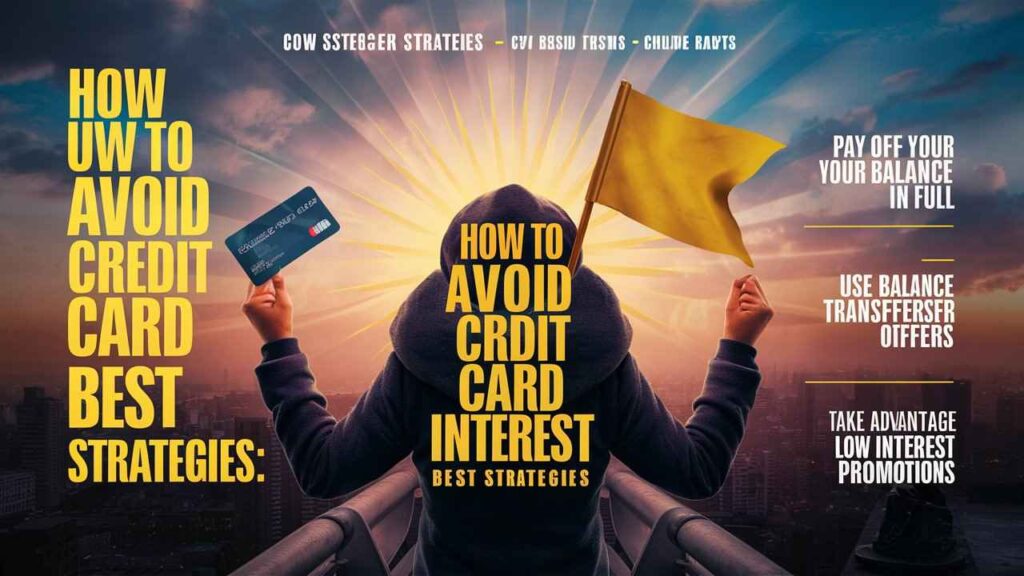In a world where plastic reigns supreme, navigating the labyrinth of Credit Card Interest can feel like trying to escape a particularly sticky web. Fear not! This guide is your trusty compass, leading you through the ins and outs of Credit Card interest and providing you with an arsenal of strategies to sidestep those pesky fees. So, grab your favorite caffeinated 💳beverage and prepare to conquer the credit world like a pro!

TAKING in Credit Card Interest: The Basics
At its core, Credit Card Interest is the cost of borrowing money on your Credit Card. Think of it as the price you pay for convenience; however, unlike your morning latte, it can escalate quickly if you’re not careful. When you carry a balance, your lender charges interest based on the Annual Percentage Rate (APR). This rate can vary widely, akin to the unpredictable weather in a temperamental city💳one day it’s sunny, the next, you’re caught in a downpour of fees. Understanding the nuances of Credit Card Interest is the first step in avoiding it altogether.
The Anatomy of Credit Card Interest Rates
Credit Card Interest rates are not just arbitrary numbers; they are carefully calculated based on several factors, including your credit score, payment history, and market trends. High-risk borrowers💳those with a checkered past of late payments💳may find themselves facing exorbitant rates. In contrast, the financially savvy can enjoy lower rates, akin to being offered a VIP pass at a crowded concert. Understanding these rates empowers you to make informed decisions about which Credit Card to wield and how to wield it effectively.

How Credit Card Interest Accrues: Time is Not on Your Side
Ah, the silent assassin of your finances: time. Credit Card Interest accrues daily, like a relentless tide creeping up the shore. If you don’t pay your balance in full by the due date, interest begins to pile up, compounding like a snowball rolling downhill. Each day you carry a balance, that interest is added to your total, increasing the amount you owe and your next minimum payment. Time may heal all wounds, but it won’t save your bank account from the ravages of Credit Card Interest.
The True Cost of Ignoring Interest Payments
Ignoring your Credit Card payments is like inviting a vampire into your home💳what seems harmless at first can lead to an all-consuming disaster. The longer you ignore your balance, the higher your payments will become, potentially spiraling into a cycle of debt that feels more like a high-stakes game of roulette than a financial strategy. Understanding the true cost of ignoring interest payments is essential: every dollar in interest is a dollar that could have been spent on something far more enjoyable, like that dream vacation or a snazzy new gadget.

How to Read Your Credit Card Statement Like a Pro
Reading a Credit Card statement can feel akin to deciphering hieroglyphics💳confusing and laden with symbols. But fear not, savvy spender! Focus on key components: the statement balance, minimum payment due, payment due date, and the APR. These figures will guide you in making smart financial decisions. Familiarize yourself with any fees, as these can sneak up on you like a ninja in the night, causing your balance to balloon faster than you can say “interest rate.”
Strategies to Avoid Credit Card Interest
Pay Your Balance in Full: The Holy Grail of Savings
If there were a holy grail in the realm of personal finance, it would undoubtedly be the ability to pay your Credit Card balance in full each month. This strategy not only saves you from Credit Card Interest but also keeps your credit score glowing like a freshly polished trophy. Paying in full demonstrates financial responsibility, ensuring your credit utilization ratio stays low and your peace of mind remains high.

Understanding Grace Periods: Your Secret Weapon
Grace periods are like financial fairy dust💳mysterious yet magical. This period occurs between the end of your billing cycle and your due date, allowing you to pay your balance without incurring interest. However, to reap this benefit, you must pay your balance in full each month. It’s a beautiful system that rewards diligent savers and keeps pesky interest at bay.
Setting Up Automatic Payments: Bye-Bye Late Fees
Setting up automatic payments is akin to having a personal assistant who never sleeps. This strategy ensures your payments are made on time, preventing late fees and interest from crashing your financial party. However, be cautious: always maintain sufficient funds in your account to avoid overdraft fees. An automatic payment schedule can provide peace of mind, allowing you to focus on more enjoyable pursuits💳like binge-watching your favorite series.
Utilizing Balance Transfers: When and How to Make Them Work
Balance transfers can be a strategic move akin to playing chess against your finances. By transferring high-interest debt to a card with a lower rate (or a promotional zero-interest rate), you can save significantly on interest. However, beware of balance transfer fees that may dampen your savings. Carefully read the fine print and ensure the terms are favorable before making this leap.
The Power of Budgeting: Keep Your Spending in Check
Budgeting may seem tedious, like watching paint dry, but it is your trusty financial roadmap. By allocating a specific amount for each spending category, you can curb impulsive purchases and ensure you have enough left over to pay off your Credit Card balance in full. Embrace tools like spreadsheets, apps, or good old-fashioned pen and paper to track your spending and stay on course.💳

Leveraging Introductory Offers: The Sweet Taste of Zero Interest
Introductory offers can feel like finding a hidden treasure chest💳often filled with zero-interest periods that make financial dreams come true. These promotions provide an excellent opportunity to make large purchases while sidestepping Credit Card Interest for a limited time. Just remember to read the fine print, as the rates can jump dramatically once the promotional period ends.
The Art of Strategic Spending: Knowing When to Use Your Card
Mastering the art of strategic spending is akin to being a culinary artist in the kitchen💳you must know when to sprinkle a little spice and when to hold back. Use your Credit Card for essential purchases or rewards-eligible expenses, but avoid the temptation to overspend. Keeping your eye on the prize💳interest-free living💳will help you resist the siren call of spontaneous shopping sprees.
Building an Emergency Fund: Your Financial Safety Net
An emergency fund acts as a financial parachute, ready to deploy when life throws unexpected curveballs💳think car repairs, medical expenses, or surprise birthday parties. By saving a portion of your income, you create a cushion that allows you to avoid relying on your Credit Card in times of need, thus steering clear of Credit Card Interest.
Using Cash or Debit: Sometimes Old-School is the Best School
In an age dominated by swiping and tapping, reverting to cash or debit can feel like a retro revolution. Using cash can limit your spending to what you physically have, while debit cards keep you grounded in reality. This strategy helps you avoid the slippery slope of Credit Card Interest, reminding you that sometimes, simplicity is the ultimate sophistication.💳
Avoiding Cash Advances: Why They’re a No-Go Zone
Cash advances are like that friend who always shows up uninvited💳convenient in theory but costly in practice. They come with steep fees and high-interest rates that begin accruing immediately. Avoiding cash advances will save you from unnecessary financial heartache, allowing you to focus on more prudent spending habits.

The Importance of Credit Utilization: Keep It Below 30%
Credit utilization refers to the amount of credit you’re using compared to your total credit limit. Keeping this ratio below 30% is crucial for maintaining a healthy credit score. A high utilization rate can signal to lenders that you may be overextending yourself, increasing the likelihood of higher Credit Card Interest rates. Monitor your spending and make timely payments to keep your utilization in check.
Understanding Your Credit Limit: Play It Smart
Your Credit Card limit is not just a number; it’s a guideline that helps you manage your spending. Understanding this limit allows you to budget effectively and avoid exceeding it, which could lead to hefty over-limit fees. Treat your Credit Card limit as a challenge to navigate, making responsible choices that reflect your financial goals.💳
When to Consider a Credit Union: The Interest Advantage
Credit unions often offer more favorable terms than traditional banks, including lower interest rates on Credit Cards. If you find yourself consistently facing high Credit Card Interest, it may be time to explore your options and consider joining a credit union. Their member-focused approach could save you money in the long run.
The Role of Rewards Programs: Spend Smart, Save More
Rewards programs are like cherry on top of your financial sundae💳offering benefits for responsible spending. By using a Credit Card with a rewards program for everyday purchases, you can accumulate points, cash back, or travel miles while avoiding Credit Card Interest. Just remember to pay off the balance each month to fully enjoy the sweet rewards.
Educating Yourself: Financial Literacy is Key
In the realm of personal finance, knowledge is power. Understanding the mechanics of Credit Card Interest and the various strategies to avoid it can empower you to make informed decisions. Consider reading books, attending workshops, or exploring online resources to bolster your financial literacy. The more you know, the more effectively you can navigate the intricate world of credit.💳
Finding Financial Tools and Apps: Your Personal Finance Sidekicks
In today’s digital age, a plethora of financial tools and apps are available to assist you in managing your finances. From budgeting apps to Credit Card tracking tools, these digital sidekicks can simplify your financial life and help you stay on top of your payments. Embrace technology to streamline your budgeting efforts and avoid the pitfalls of Credit Card Interest.💳
Consulting a Financial Advisor: When Expert Advice Pays Off
Sometimes, you need a little extra help navigating the financial labyrinth. Consulting a financial advisor can provide tailored strategies to manage your Credit Card debt effectively. These professionals can guide you through complex financial landscapes and help you develop a plan to avoid Credit Card Interest for good.
Conclusion: Your Path to Interest-Free Living
Avoiding Credit Card Interest is not just a pipe dream; it’s an achievable reality with the right strategies in place. By understanding the mechanics of Credit Card interest, developing sound financial habits, and leveraging the tools at your disposal, you can pave your path to interest-free living.
Call to Action: Share Your Best Tips to Avoid Credit Card Interest!
Now that you’re armed with a treasure trove of knowledge, it’s time to take action! Share your own strategies and tips for avoiding Credit Card Interest in the comments below. Together, we can conquer the financial jungle and ensure our hard-earned cash stays where it belongs💳in our pockets!
People Also Ask
How much interest is taken on credit card?
The interest charged on a Credit Card can vary significantly based on the Annual Percentage Rate (APR), your credit score, and the card issuer. Typically, Credit Card Interest ranges from about 15% to 25%, although some cards may charge even higher rates. For instance, if you have a balance of $1,000 with a 20% APR, you could pay around $200 in interest over the course of a year, assuming you don’t make any payments.💳
What is 24% APR on a credit card?
A 24% APR on a Credit Card indicates that if you carry a balance, you will be charged 24% of that balance in interest over a year. This translates to a monthly interest rate of 2%. For example, if you have a balance of $1,000, you would incur about $20 in interest charges each month if you don’t pay it off.
How do I avoid paying interest on my credit card?
Avoiding Credit Card Interest is achievable with a few strategies:
- Pay Your Balance in Full: Always aim to pay your balance in full before the due date.
- Utilize Grace Periods: Take advantage of any grace periods offered by your card issuer.
- Set Up Automatic Payments: This ensures you never miss a payment.
- Stay Informed: Regularly review your statements to monitor your spending.
Is credit card interest free?
Credit Card Interest can be interest-free during a grace period, which typically lasts between 21 to 25 days after the billing cycle ends. To qualify for this, you must pay your previous balance in full. However, if you carry a balance from one month to the next, interest will accrue.
Is it good to pay credit card interest?
Paying Credit Card Interest is generally not ideal. It signifies that you are carrying a balance and incurring extra costs for borrowing money. Instead, aim to pay off your balance in full to avoid interest charges and maintain financial health.
How much of my credit card bill is interest?
The amount of your Credit Card bill that is interest depends on your balance and the APR. If your statement shows a $100 interest charge for a month and your total bill is $1,000, then 10% of your bill is interest. Review your statement to see the interest amount and calculate its percentage of the total.
How to calculate interest charge?
To calculate your Credit Card Interest charge:
- Determine Your Daily Balance: This can vary based on payments and purchases.
- Divide Your APR by 365: This gives you the daily periodic rate. For example, a 24% APR is approximately 0.0658% daily (24/365).
- Multiply by Your Daily Balance: The result is the interest charge for that day.
Is credit card interest charged per day?
Yes, Credit Card Interest is typically charged daily. Most issuers calculate interest daily based on your daily balance and the daily periodic rate derived from your APR. This means that the longer you carry a balance, the more interest you accrue.
How to calculate interest?
To calculate interest on a Credit Card:
- Identify the Daily Rate: Divide your APR by 365.
- Calculate Your Average Daily Balance: Keep track of your balance over the billing cycle.
- Multiply: Daily rate × Average daily balance × Number of days in the billing cycle = Total interest charge.
Why is credit card interest so high?
Credit Card Interest tends to be high due to the perceived risk associated with lending money to consumers. Factors such as credit history, payment patterns, and the unsecured nature of most Credit Cards contribute to elevated rates. Lenders charge higher interest to offset the potential for default.
Which credit card is low interest?
Low-interest Credit Cards typically offer APRs that are lower than the average market rate, often around 10% to 15%. These cards may not offer extensive rewards but can save you money if you tend to carry a balance. Research and compare various options to find the best fit for your needs.
How to calculate daily interest?
To calculate daily interest on a Credit Card:
- Take the APR and divide by 365 to find the daily rate.
- Multiply the daily rate by your balance. For example, if you have a $1,000 balance with a 24% APR, your daily interest would be approximately $0.66 ($1,000 x 0.0006575).
What is the minimum payment on a $3000 credit card?
The minimum payment on a $3,000 Credit Card balance can vary by issuer but is usually calculated as a percentage of the balance (typically 1% to 3%) plus any interest charges. For example, if your minimum payment is 2% of the balance, it would be $60.
Do I pay APR if I pay on time?
If you pay your balance in full by the due date, you typically won’t incur Credit Card Interest, meaning you avoid paying APR. However, if you only make the minimum payment or carry a balance, then interest will apply.
Is APR charged monthly?
While APR is expressed as an annual rate, interest charges are calculated monthly based on your balance. The monthly interest is derived from the daily rate calculated from the APR and is added to your balance.
Is 30% APR good?
A 30% APR is considered quite high and is generally not favorable. It indicates that borrowing on this Credit Card can become expensive, making it essential to pay off your balance quickly to avoid excessive interest charges.
How is credit card interest calculated?
Credit Card Interest is calculated based on the daily balance and the daily periodic rate, which is derived from the APR. The formula involves multiplying the daily balance by the daily interest rate and the number of days in the billing cycle to determine the total interest owed.
Is credit card interest monthly?
Yes, while the APR is annual, Credit Card Interest is assessed monthly based on your balance. The interest charged is typically reflected on your monthly statement, showing how much you’ve accrued during that billing cycle.
Can I freeze my credit card interest?
Some credit card issuers may allow you to temporarily freeze interest rates under specific circumstances, such as financial hardship. Contact your issuer to inquire about any programs they may offer.
Can credit cards remove interest?
Credit card issuers may offer to waive interest under certain conditions, such as promotional offers or during hardship programs. It’s crucial to communicate with your lender and understand any terms that may apply to these offers.









